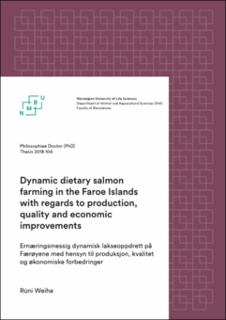| dc.contributor.advisor | Thomassen, Magny | |
| dc.contributor.advisor | Rør, Kjell-Arne | |
| dc.contributor.advisor | Hatlen, Bjarne | |
| dc.contributor.author | Weihe, Rúni | |
| dc.coverage.spatial | Faroe Islands | en_US |
| dc.date.accessioned | 2021-12-15T13:39:04Z | |
| dc.date.available | 2021-12-15T13:39:04Z | |
| dc.date.issued | 2018 | |
| dc.identifier.uri | https://hdl.handle.net/11250/2834499 | |
| dc.description.abstract | The development of feeds for Atlantic salmon has been an ongoing process since the industry started in the 1970s. In the early years, salmon feeds had higher share of proteins than lipids, but after the introduction of extrusion and vacuum coating technology in the feed manufacturing process, the dietary protein-to-lipid ratio was reduced below 1 during the mid 1990s. Correspondingly, the development in dietary lipids has increased overall dietary energy in feeds for salmon. In addition to the oils having increasingly replaced proteins, the traditional marine proteins and oils have also been substituted with plant alternatives which now represent the main ingredients in salmon feed. The combination of reduced dietary protein and use of plant ingredients results in a lower feed price compared to feed prices based on both higher protein content and high marine ingredient inclusions.
In this thesis, the preferred dietary strategy using high-fat feeds in the salmon industry has been tested and compared with an isoenergetic protein denser dietary strategy. Thus, the thesis presents the main results of dietary induced differences in two isoenergetic diets with a high proteinto-lipid ratio (HP) and low protein-to-lipid ratio (LP) with regards to biometric production performance (Paper I, II), morphometric quality attributes (Paper I, III) and economic performance (Paper IV). The presented results are based on experiments conducted in both large-scale commercial facilities (Paper II, III) as well as in small-scale research environment (Paper I, II, III). Results from the large-scale trials were based on the whole production cycle, whereas within the two small-scale experiments, the results were based on three separate feeding periods. Experimental fish in the second small-scale trial was based on restocked fish fed HP diets in the first small-scale trial. | en_US |
| dc.description.abstract | Utvikling av fôr til atlantisk laks har vært en kontinuerlig prosess siden industrien startet på 1970-tallet. I de første årene hadde laksefôret en høyere andel av proteiner enn lipider, men etter innføring av ekstrudering- og vakuumerings-teknologi i fôrproduksjonen ble protein-til-lipidforholdet redusert til under 1 i midten av 1990-tallet. Tilsvarende har utviklingen i lipid-innhold økt den totale energien i fôr til laks. I tillegg til at oljer har erstattet proteiner i økende grad, har de tradisjonelle marine proteiner og oljer også blitt erstattet med plantealternativer som nå representerer hovedbestanddelene i laksefôr. Kombinasjonen av redusert protein-innhold og bruk av plantebestanddeler resulterer i lavere fôr-pris sammenlignet med priser av fôr basert på høyere proteininnhold og/eller mer marine ingredienser.
I dette arbeidet har lakseindustriens foretrukne ernæringsmessige strategi, med bruk av høyfett-fôr, blitt testet og sammenlignet med en iso-energetisk men mer proteinrik strategi. De viktigste resultatene som ble funnet ved bruk av to iso-energetiske dietter med et høyt protein-til-lipidforhold (HP) og et lavt protein-til-lipidforhold (LP) med hensyn til biometriske produksjons-egenskaper (Artikkel I, II ), morfometriske egenskaper (Artikkel I, III) og økonomisk ytelse (Artikkel IV) er beskrevet. Resultatene er basert på eksperimenter utført både i store kommersielle anlegg (Artikkel II, III) og i småskala forsøk (Artikkel I, II, III). De store forsøkene var basert på hele produksjonssyklusen, mens resultatene i de to småforsøkene var basert på tre separate fôringsperioder. Fisk som ble benyttet i den andre småskala-perioden kom fra fisk gitt HP-dietter i det første småskala forsøket. | en_US |
| dc.description.sponsorship | Havsbrún PF ; The Faroese Research Foundation ; Statoil Faroes | en_US |
| dc.language.iso | eng | en_US |
| dc.publisher | Norwegian University of Life Sciences, Ås | en_US |
| dc.relation.ispartofseries | PhD Thesis;2018:104 | |
| dc.rights | Attribution-NonCommercial-NoDerivatives 4.0 Internasjonal | * |
| dc.rights.uri | http://creativecommons.org/licenses/by-nc-nd/4.0/deed.no | * |
| dc.title | Dynamic dietary salmon farming in the Faroe Islands with regards to production, quality and economic improvements | en_US |
| dc.title.alternative | Ernæringsmessig dynamisk lakseoppdrett på Færøyene med hensyn til produksjon, kvalitet og økonomiske forbedringer | en_US |
| dc.type | Doctoral thesis | en_US |

